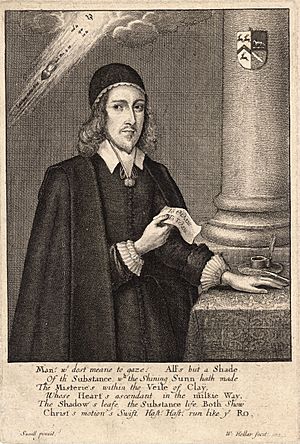John Rogers (Fifth Monarchist) facts for kids
John Rogers (born in 1627) was an English preacher in the 1650s. He was part of a religious group called the Fifth Monarchists. Later in his life, he became a doctor.

Contents
Early Life and Education
John Rogers was born in Messing, a town in Essex, England. He was the second son of a clergyman named Nehemiah Rogers. In 1642, his father sent him away because of his strong religious beliefs.
He then went to King's College, Cambridge to study medicine. However, the First English Civil War had begun, and he had to leave. Rogers struggled for a while, but in 1643, he found work teaching at a school in Huntingdonshire. He also taught at a free school in St. Neots.
Becoming a Preacher
Soon, John Rogers became well-known as a preacher in Huntingdonshire. He returned to Essex and became an ordained minister in 1647. Around this time, he married a daughter of Sir Robert Payne. He then became a minister in Purleigh, Essex.
Rogers hired someone to help him with his duties and moved to London. There, he changed his religious views and joined a group called the Independents. He began giving powerful political sermons at St. Thomas Apostle. These sermons supported the Long parliament, which was the English Parliament at the time.
In 1650, Parliament sent him to Dublin, Ireland, to preach. Christ Church Cathedral, Dublin was given to him as a place of worship. However, his congregation split because some members adopted new religious ideas. Rogers grew tired of the arguments and returned to England in 1652. The next year, he lost his job in Purleigh because he was not living there.
Rogers's views changed again. In 1653, he published two books. One book, Bethshemesh, criticized the Presbyterians. The other, Sagrir, attacked what he called the "ungodly laws" and the collection of church taxes. This second book showed that he had become a Fifth Monarchist. This group believed that Jesus Christ would soon return to Earth to rule. Rogers approved when the Long Parliament was dissolved.
Imprisonment and Political Views
After Oliver Cromwell took power, Rogers wrote to him, suggesting a new way of governing. However, this agreement did not last. When Cromwell dissolved his first parliament and became Lord Protector, Rogers began to criticize him openly.
In 1654, Rogers was accused of being a conspirator. His home was searched, and his papers were taken. He continued to speak out against Cromwell. On March 28, he preached a sermon where he compared Whitehall (Cromwell's residence) to Sodom. He also said that Cromwell had broken many commandments. This led to his arrest and imprisonment in Lambeth.
On February 5, 1655, he was brought before Cromwell from prison. Rogers stood by his words and reminded Cromwell that he would also be judged. He was moved to Windsor and then to the Isle of Wight. He was finally released in January 1657 and immediately went back to London.
The Fifth Monarchists were involved in secret plans at this time. Rogers was accused many times, and on February 3, 1658, he was sent to the Tower of London. He was released on April 16. Four and a half months later, Cromwell died. Rogers strongly opposed Richard Cromwell taking his father's place. Rogers believed in a republic where Christ himself would be the invisible ruler.
Later Life and Medical Career
After the English Restoration (when the monarchy was brought back), John Rogers moved to the Netherlands. He went back to studying medicine at universities in Leyden and Utrecht. He earned a medical degree from Utrecht.
In 1662, he returned to England and lived in Bermondsey. In 1664, he received another medical degree from Oxford University. The exact date of his death is not known. His oldest and only surviving child was Sir John Rogers, 1st Baronet.

